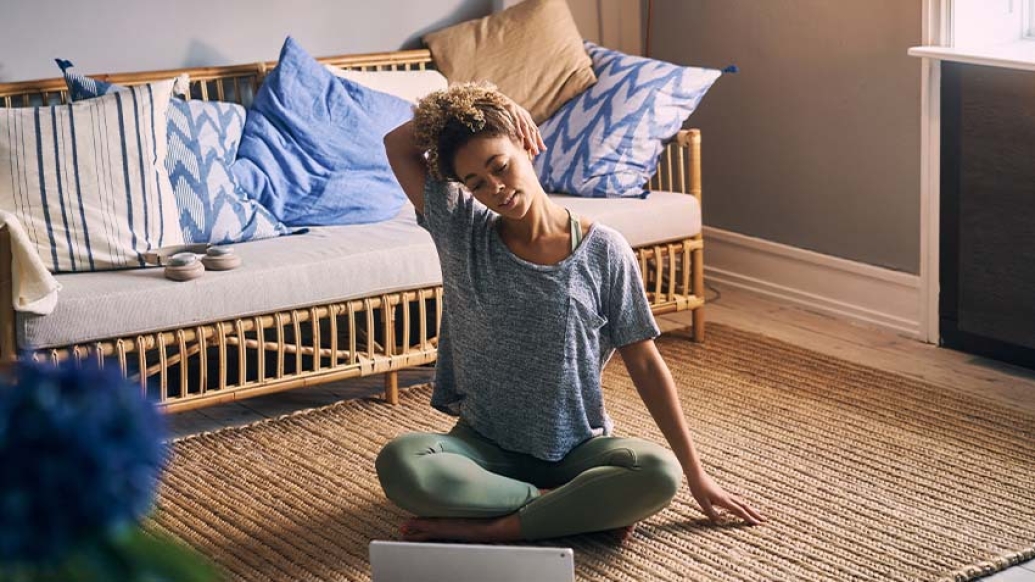And why researchers say not to neglect your neck muscles.
3:28 PM
Author |

Many are getting back to the gym, golf course or tennis court following a 'COVID hiatus'.
As you amp up your active pursuits, Michigan Medicine sports medicine specialists offer a gentle reminder: Put some of that pent-up energy into exercises that build your core muscle strength and improve stability.
"Research supports a link between strengthening the core – the muscles of the abdomen, hips and back – and reducing the occurrence and severity of injuries," said physical medicine and rehabilitation specialist Andrea Aagesen, D.O. "Anecdotal evidence suggests that the same may be true for strengthening the neck to protect against head injuries."
"Intuitively, it makes sense that a strong neck can help protect your head when playing a contact sport," said PM&R physician researcher James Eckner, M.D., M.S. Eckner is director of clinical research for Michigan NeuroSport. "But research to date hasn't taught us enough about the relationship between neck strength and concussion to make evidence-based recommendations."
Eckner, who is also associate director of research for the U-M Concussion Center, has launched a research study specifically focused on neck strength and conditioning.
In the meantime, though, he says, don't wait to start a sports conditioning routine.
"Nearly everyone, regardless of age, fitness level or activity of choice, can benefit from strength and conditioning training," said Aagesen. "Many of the injuries that bring patients to our clinic can be linked to insufficient conditioning."
Need more reasons to pay attention to your core strength? Aagesen and Eckner give three:
1. A stronger core is an insurance policy against all kinds of injuries
"Core strength is especially helpful in preventing injuries of the lower extremities – hips, legs and ankles – that can result from running, jumping or lateral/cutting movements in sports like soccer," Aagesen says. "But people are surprised to learn that weak core muscles also pose a risk to the upper body, increasing the chance of shoulder or elbow injuries from throwing, rowing, volleyball or racquet sports."
MORE FROM MICHIGAN: Sign up for our weekly newsletter
2. When we rely too much on lower leg and arm muscles to compensate for inadequate core strength, overuse injuries can result
"Both research and our clinical experience has shown that sprains, tendon tears, and stress fractures – sometimes very serious ones – can result when core muscles are not strong and responsive enough to react quickly to the forces from the ground when we run, jump, and cut," Aagesen explained. "For example, insufficient or imbalanced strength in the hip and hamstring muscles contribute to anterior cruciate ligament (ACL) tears, which may require surgery."
3. The increased stability gained through core exercises has also been shown to improve balance, which is especially important as we age
"Often, we see patients whose exercise routines consist of walking only," says Aagesen. "Walking is terrific for cardiovascular health, but patients can develop strength deficits in the hip, abdominal, oblique and back muscles if they are only moving their bodies forward and backwards. Training these muscles can really help improve side-to-side movement and may prevent falls down the road."
We hope the study will provide more specific direction on how much gain in neck strength is needed to make a difference.James Eckner, M.D., M.S.
Landing on the right routine
While strength and stability can benefit every body, the key to protecting against injury is to find the right strength –and stability—building exercises for your age, fitness level and particular sport or activity. Aagesen offers these age-appropriate guidelines:
-
Young children (age 6 and under): The very young tend to go in all directions – crawling on their hands and knees, climbing – movements that naturally contribute to a stronger core. "From toddler to pre-teen, the best approach is to just encourage a variety of play," she says. "Anyone who has chased a toddler around knows what a great workout it is."
-
Adolescents and young adults: By the time they reach high school, young athletes begin to focus the skills needed for a specific sport and may not be exposed to any core conditioning outside of the basics of gym class. Instead of building a base of core strength, they tend to compensate with other muscles. "I see young athletes – even elite college athletes – with very weak cores," says Aagesen. "Some don't have the core strength of my active patients in their 80s." Most issues are seen with early sports specialization, where an athlete only focuses on playing one sport for most of the year. Playing more than one sport can help an athlete train different muscles as each sports season will have a different demand on the muscles and joints. Aagesen recommends that, as early as possible before a sport season, student athletes reach out to their coaches for guidance on conditioning.
-
Adult "weekend warriors": For those who are just a little rusty, or are starting something new, but are otherwise generally healthy and injury- and pain-free, developing a core strength routine is a smart move. The objective is to do a variety of exercises to develop stomach, back and side torso muscles. "It's not all about crunches," cautions Aagesen. "Many people work the abs, but do little for those other areas." Performing a variety core-building moves, like planks, bridges and leg lifts can be more effective than crunches. Establishing the right form is important to get maximum benefit with minimum injury risk. Online videos, beginning group fitness classes, and personal training sessions are options for learning these exercises, after which most people can continue with a self-guided routine.
-
Older adults: Preserving movement and avoiding falls are the key goals for this group. But it's also important to remember that weak core muscles can make it more difficult to sit up straight. Poor posture and slouching can cause back pain. For those who are limited with their activity from pain or weakness or are unsteady on their feet, physical therapy can be an important key to develop the strength and stability their bodies need. The seniors who are more active, can often perform a slightly modified version of the same exercises as the younger adults, but should listen to their bodies and start with what is comfortable for them to complete. Some of the core moves recommended above can be modified further if needed, such as side crunches and leg lifts, which can be done while seated in a chair, but it is best to do some exercises for your legs as well. Often working with a physical therapist can be very helpful in this group to build up the strength in the safest way for your body.
Neck strength and injury prevention: New research
While strengthening our core can help prevent upper and lower body injuries, the role of neck strength in prevention of head injuries is still unknown.
To better quantify the benefits of neck strength for concussion risk reduction, Eckner has designed a study that combines supervised neck strengthening exercises with safe, standardized lab tests that measure the connection between neck strength and the head acceleration associated with an impact to the head.
Like Podcasts? Add the Michigan Medicine News Break on iTunes, Google Podcasts or anywhere you listen to podcasts.
"We hope the study will provide more specific direction on how much gain in neck strength is needed to make a difference," he says.
"While there is concussion risk with many sports and athletes of all ages, for this study we're currently recruiting high school age soccer players, both male and female," Eckner explains. "At this age, athletes are unlikely to have done much conditioning, making it easier to measure incremental gains. And we're working with soccer players because one of the actions we'll be observing is heading a soccer ball."
All participants work out with U-M strength and conditioning specialists, and all receive the same conditioning training from the shoulders down – building arm, leg and core strength. But participants are randomly assigned to either a neck strengthening group – that receives additional exercises that target neck muscles – or a control group that does not.
At the start and at regular points throughout the study, all of the athletes are evaluated for a number of factors, using a range of sophisticated tools available through the U-M Biomechanics Research Lab.
Learn more about the study or contact the study coordinator at 734-936-7704.
When to seek professional help
Regardless of age, individuals who have injuries or experience pain with activity should work with a conditioning specialist. When possible, an evaluation by a physical therapist can identify deficits and problems and before they become severe. Primary care and non-surgical sports medicine physicians are also great resources for exploring the biomechanics behind a problem and recommending the right course of action.
Conditioning before starting a new sport or activity, or when changing from one sport to another, is also a good time to seek advice from a pro.
"For example, when transitioning from swimming to a sport with running and lateral movements like tennis or soccer requires targeted conditioning," Aagesen explains. "A physical therapist, athletic trainer, or personal trainer can help with exercises to build weight-bearing strength in feet, ankles and legs to avoid injury."
If you have any current or prior injuries that have changed the way you move and perform, it may be best to see a sports medicine physician to help get you started.

Explore a variety of health care news & stories by visiting the Health Lab home page for more articles.

Department of Communication at Michigan Medicine
Want top health & research news weekly? Sign up for Health Lab’s newsletters today!





